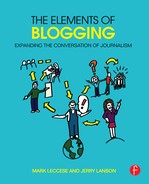1
Anatomy of a Blog Post
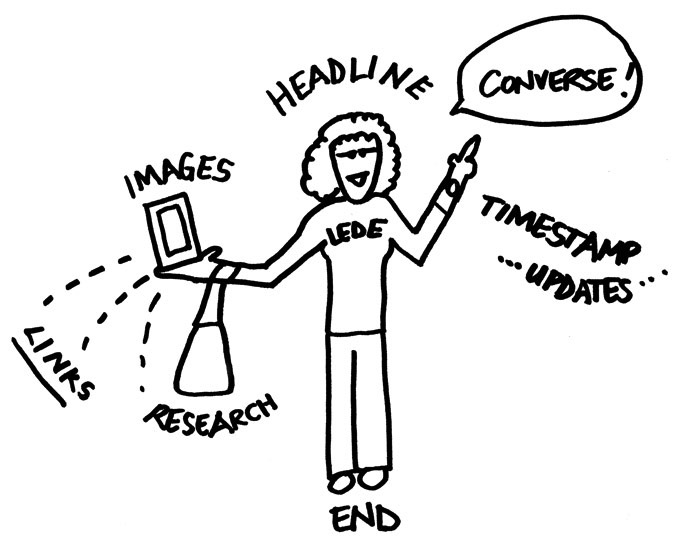
What makes an effective blog post is an audience. But to get there, you’ll need an original, focused topic; a clear headline that draws ever-fickle readers in; good pictures or graphics; tight writing; links to other media; a bit of personality; and the opportunity for others to talk with you or talk back at you.
Blogging has its similarities to traditional journalism. What makes it different is a little more voice and a lot more of a level playing field with readers. In some ways, in fact, it has filled the void of everyman journalism, as mainstream publications become more expensive and more written for and by elites. In contrast, the blogosphere is meant for the writer and reader to converse in ways traditional journalism never achieved, but at the same time for that writer to bring something new—a perspective, facts, expertise—to the discussion.
Let’s dissect the elements of an effective blog post. One of this book’s authors, Mark Leccese, wrote this post, which is about the first 48 hours of media coverage of the one of the biggest news stories of 2010—the BP offshore rig oil spill disaster in the Gulf of Mexico.
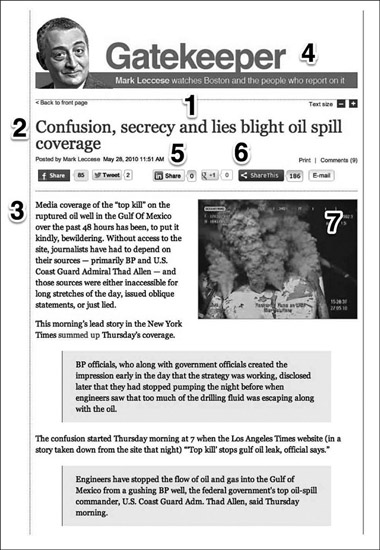
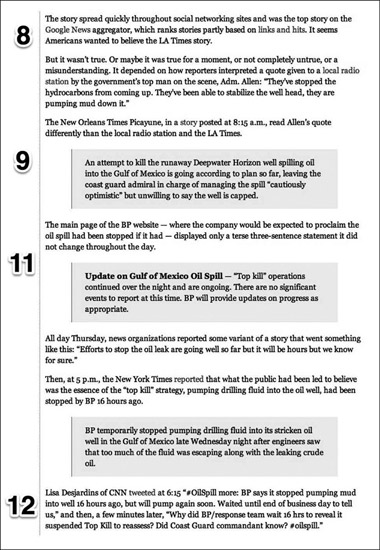
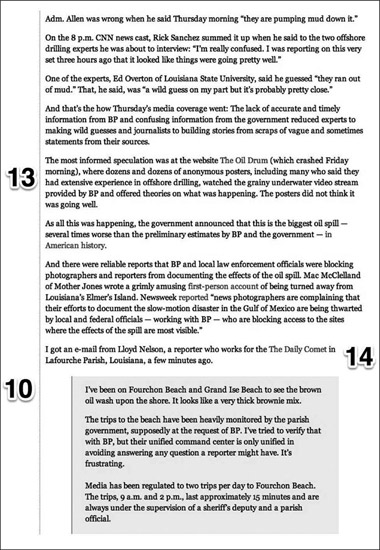
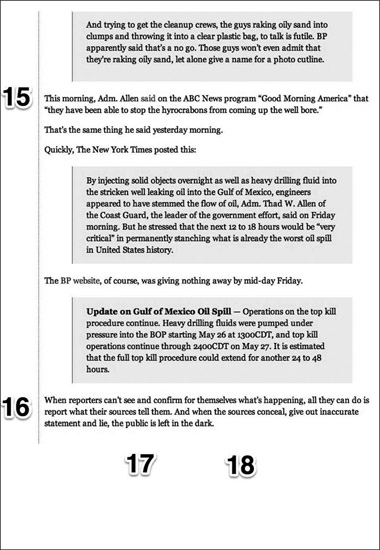
-
1. Collect your research and collect your thoughts. Too many bloggers just fire up their blogging software, write, and hit the “Publish” button. Their posts are rarely worth reading.
Writing is a process. It begins with your choice of a topic. Next, you need to gather information. The phone calls you make, the interviews you conduct, the documents you read, and the situations you observe are all part of this information gathering. Along the way, you have to organize and clarify your thoughts. Take something as simple as a restaurant review. You need to collect information: What’s on the menu? What’s the signature dish? How is the food prepared? What are the prices? Who are the clientele? Once you know this, you also need to collect your thoughts. What do you want to say? Even if you are writing about memories of your senior prom, you’ll need to sit for a while and think through your experience before you start to write.
We’ll talk much more about finding a focus, organizing, and writing a blog post in Chapter 2, “Two Models: The Reporter Blogger vs. The Op-Ed Blogger.”
-
2. Write a crisp, clear headline. The sign on a storefront is important. It tells you what the store sells. The headline on a blog post is more important, because it not only tells you what the post is about, but also has to be interesting enough to convince you to read further.
We have devoted Chapter 6, “Why Headlines Matter,” to headline writing. Headlines are that important. On top of a blog, a headline serves two purposes: it draws the reader into the post and contains keywords that Google and other search engines will look for. Making your blog as visible to Google as it can be is called search engine optimization, known in short as SEO, and a good blog headline combines cleverness, usefulness, and smart SEO.
The headline on Mark’s piece was, “Confusion, secrecy and lies blight oil spill coverage.” In writing, Mark was careful to include the words “oil spill,” since he knew that would be a common search term as the disaster continued. Since the blog post is about the media’s coverage of the oil spill, he wanted the word “coverage” in the headline, too. Then, trying to lure both readers and search engines, Mark chose three nouns—“confusion,” “secrecy,” and “lies”—to build the headline. With these keywords, readers would know instantly what the blog post is about. And because of the way search engines work, anyone punching “oil spill coverage” or “oil spill lies” would be much more likely to find a link to Mark’s blog post.
-
3. The lede. If you’ve been trained in writing ledes for print news stories or broadcast news stories or press releases, you’ve got an excellent foundation for writing the first paragraphs of blog posts. But (isn’t there always a but?) the first paragraph in a blog post differs in some important ways from a traditional new lede.
A blog post lede is more conversational. News ledes strive for an anonymous voice, but, as a blogger, you want a distinctive voice. In the first paragraph of the example, Mark used conversational phrases he would have hesitated to use in a news story: “media coverage … over the past 48 hours has been, to put it mildly, bewildering” and “those sources were inaccessible for long stretches of the day, issued oblique statements, or just plain lied.”
Try to get “to put it mildly” or “just plain lied” past a news editor. Good luck. Notice, though, that the main point of the blog post is in the first paragraph: media coverage has been “bewildering” because reporters have had little access to sources.
If the first paragraph is a little different from a news lede, it is very different from a term paper first paragraph. If you start a blog post the way you start a term paper—with a long paragraph in which the main point doesn’t come until the final sentence—you’ll drive the reader away.
If your first sentence doesn’t engage the reader and tell the reader what the post is about, the reader needs only to tap the mouse to leave your blog behind and head off to somewhere more interesting on the Internet.
-
4. Give the page a standing design and headline. In newspaper design, a “standing head” is a graphic element that identifies a recurring feature. A blog should have a standing head—a distinctive look that makes it recognizable when a reader lands on your page. Your blog needs to stand out from the hundreds of millions of other blogs on the Web.
We’ll talk about the look of the whole blog in Chapter 3, “Getting Started.” But remember that a reader’s eyes go to the top of a web page first. That piece of real estate needs to communicate.
Professional designers at The Boston Globe designed the standing head in this example. The designers converted a photograph of Mark to what is called a “hedcut,” made famous by the Wall Street Journal and created by designer and illustrator Kevin Sprouls. Sprouls uses a pencil, a technical fountain pen, and an eraser—each hedcut takes him hours. (He describes how he does it here: www.sprouls.com/blog/2012/01/sprouls-method-the-hedcut/.) You can achieve a very similar effect in Photoshop by stippling and hatching an image, and there are inexpensive mobile apps that can make a hedcut. Your photo at the top of your blog—or anywhere easily visible on the page—helps establish your personality. You are more than text on a screen; you’re a person.
We’ll talk more in Chapter 3, “Getting Started,” about choosing a name for your blog.
-
5. Use a time stamp. A bit of trivia for you: the word “blog” is an ugly portmanteau of “web log.” And a log is written in reverse chronological order—the newest entry will always be on top. So it is with a blog; it’s one of the things that makes a blog a blog and not, say, a website. Your most recent blog post will always be on top of your blog.
The time stamp tells the reader the date, year, and time you published each blog post. For as long as you leave your blog online (even if you haven’t posted to it in ages), it will be visible to search engines. When readers come across something you wrote, they’ll want to know when it was written. The time stamp is particularly important when you’re blogging about the news, or sports, or even the weather.
In most blog software, time stamps can be changed. It is possible to publish a post on Monday with a time stamp that falsely tells the reader it was posted last Wednesday. You’ll note the “falsely” in the previous sentence. Changing a time stamp is unethical.
-
6. Offer share buttons. The row of icons at the top of this blog post are share buttons. They are one of the best ways to build readership to your blog. If your blogging software doesn’t include share buttons automatically, you may need to add a plug-in—share button plug-ins are common, often free, and easy to install.
The share buttons allow the reader, with one click, to share your blog post via email, or on any number of social media sites, including Facebook, Twitter, Tumblr, Pinterest, or Reddit.
Most of your readers won’t come to your blog directly; they’ll find it either through a search engine or social media. Make sure to include share buttons on your blog.
-
7. Use images to help tell the story. No one wants to land on a web page and see a dense, gray, intimidating block of text. Just as the standing head, with its title and art, is part of the design of the page, so too are images. In fact, those images often help tell the story or become the main vehicle for telling the story. We live in a visual world. The more on-point images are, the more they enhance and complement what you’ve written, the more likely readers are to stay with your words. When you start thinking and planning a blog post, you should always think what images you can use to supplement or help explain the text. (We’ll have a lot more to say about images in Chapter 7, “Beyond Words.”)
Mark didn’t choose a particularly evocative photo for this blog post—it’s a photo of the destroyed wellhead spewing crude oil into the Gulf of Mexico. But his trade-off was that he wanted to be timely while the news was still fresh. So he chose the most evocative image he could find in 10 minutes.
A word of warning about images: do not use photos or infographics you download from the Internet. The vast majority of them are protected by copyright, and while lawyers for the copyright owner won’t always track you down, it’s wise not to take the chance. Violating copyright is illegal.
You have several options:
- If you are blogging for an organization or a company, you can use any images or infographics to which the company has purchased the copyright. Since Mark’s blog was published by the website of The Boston Globe, he could use any images or infographics that had been purchased by the Globe.
- Join Creative Commons (us.creativecommons.org), a not-for-profit membership organization whose purpose is to expand the amount of creative work—including images—that are in the public domain and thus legal for anyone to use.
- If you’re an independent blogger, take your own photos and make your own infographics (there are a number of useful websites that will create customized visualizations of your data). That way, you’ll not only stay on the right side of the law, but you’ll have more fun and produce more of your own work.
-
8. Think carefully about links. Millions and millions of blogs posts on the Internet contain no links at all, just text. They may as well be screenshots of a typewritten page. What makes the Internet different from all other media is hypertext—the ability to click on a word and be taken to another place on the World Wide Web. The whole foundation of the Web, in fact, is hypertext—hypertext is the “h” in “http.”
What makes the World Wide Web different from all other media is hyperlinks, the (usually) underlined words that, with a mouse click or a tap, take us to a specific page on another website. Readers who grew up in an online world may not grasp how revolutionary—and how useful—hyperlinks are.
You’re reading a magazine article that mentions Madagascar, and you realize you are not entirely sure where on this big blue earth Madagascar actually is. You touch the word “Madagascar” on the magazine page, and—presto!—an atlas appears in your hands open to the map of Southeast Africa, and there sits the island of Madagascar.
Hyperlinks serve two important purposes for a blogger: they direct the reader to further information on the topic you are writing about, and they allow the reader to see where you got the information you used to build your blog post. A hypertext link on a blog serves a similar purpose as attribution—the assigning of a fact or set of facts to a source using “so-and-so said” or “according to so-and-so”—in a mainstream media news story.
Let’s say you are writing a post about the population of people aged 65 in the U.S. doubling by 2050. Where, the reader wonders, did you get that piece of information? You got it from reading a story in the New York Times about a report issued by the United States Census Bureau. You could link to the New York Times story, which is a secondary source, but why not link to the primary source, the Census Bureau report? It’ll take you 15 seconds and one Google query to find the web page with the full Census Bureau report. By linking to the primary source, you are doing your reader a service—you are directing the curious reader to the original, in-depth source of the information.
Be creative with your links. Don’t always choose the first result you get on a topic from a Google search. Few things are more disappointing to a blog reader than to click on a link and be taken to Wikipedia. “I can look something up on Wikipedia myself,” the reader grumbles.
If you are writing about St. Francis de Sales, the patron saint of journalists and writers, you could link to the Wikipedia entry. But your reader might learn more if you dug around in your Google search results for web pages more informative, more interesting, and sometimes more fun than Wikipedia. You could link to the St. Francis de Sales page on the website The Catholic Encyclopedia. You could link to the home page of St. Francis de Sales’ most famous book, Introduction to the Devout Life. There is even a Pinterest page for St. Francis de Sales—wouldn’t your reader enjoy perusing that rather than yet another tedious Wikipedia entry?
You can also use links in your blog posts to direct your reader to differing opinions on a topic. In a blog post about a new government proposal for funding for universities in the UK, you could link to editorial writers or bloggers who both support and oppose the proposal. Again, you would be doing your reader a service.
Here’s some basic advice about using links in your blog posts:
- Link to your sources. Use links to add credibility to your posts by allowing the reader to examine your sources. If you are writing a blog post about filigree jewelry, link to the website or a blog where you learned about filigree jewelry, or to a website that has particularly fine examples. Again, try not to link to Wikipedia— your readers can find the Wikipedia entry on “filigree jewelry,” or any other topic, in five seconds. Do some searching to give your readers something informative they can’t easily find for themselves.
- Link to other bloggers. Sometimes this is called “link love,” and the idea is that if you link to other bloggers and help draw attention to their blogs, they’ll return the favor and link to your blog—which will help you draw more readers. You’re trying to create a community with your blog, right? Links to other bloggers also make your blog more valuable to readers because your readers know they can come to your blog for not just your writing but for the research you’ve done. There is also some evidence Google’s search engine takes links into account in its ranking of websites in a search, which is another good reason to link to sources and other bloggers.
- When linking to a blog post, link to the specific post and not just the blog. If you want to link to a blog post about filigree jewelry your friend Ashley just wrote, click on the headline of that post and use that URL for your link (it’s called a permalink). If you just link to www.ashleyblog.com, next week or the week after, when Ashley has written several new blog posts, her post about filigree jewelry will be at the bottom of the page and your reader—the one who clicked your link—will be confused. The perma link to Ashley’s post about filigree jewelry will look something like this: www.ashleyblog.com/2014/07/23/filigree.html. When readers click on that link, they’ll be taken to a page with Ashley’s filigree jewelry post—which is where you wanted to send them.
- Link to yourself. Once you’ve been writing a blog for a while and you’ve got a few dozen posts (or more), there’s nothing wrong with linking in a new post to one of your previous posts. You’ve built a body of work, and if you can make a point more clearly by directing the reader to a previous post of yours, do it.
- Check all your links. Before you publish your post, as part of your proofreading, click on every link you have included in the post and make sure it goes where you intended it to go. You may have made a mistake when you cut and pasted the link, and you do not want to promise the reader something you don’t deliver.
-
9. Use blockquotes. You’ll often want to quote from sources you’ve used in your research. When you want to use a direct quote that is longer than three lines or 30 words, use a blockquote. The blockquote function operates differently in different brands of blogging software, but it usually will indent the quotation on both sides and add a shaded background.
In the example from Mark’s blog, rather than paraphrasing the lede in that day’s New York Times, he quoted it. It is often useful to give your readers the exact words of the sources rather than paraphrasing. It adds credibility. It lets your readers read what you have read. Mark’s role, as a media criticism blogger, was not to report the news, but to comment on how it was covered. To do so effectively, it was important for him to give verbatim examples of that coverage.
Note that a blockquote differs from a pullquote. A pullquote is a quotation—either from a source or the writer—copied (“pulled”) from the story and placed in a larger font as a graphic element. It breaks up a solid chunk of text with some white space. A blockquote is part of the text, but it can serve the same graphic function: it breaks up a column of text and gives the eye a little relief.
Putting text in a blockquote is as simple as changing text from roman to bold. Almost all blog software has a blockquote button in the ribbon above the text entry box. WordPress, for example, uses an icon of a large open-quotation mark—just define the text you want to be a blockquote and click on the button. If you want to dig into HTML and write your own blockquote tags, you can give them various interesting looks. Most content management systems have a standard look, and that standard look (as in the example) works just fine for most blogs.
-
10. Long blockquotes are not only OK, they are helpful to the reader. In the last section of the example, there are two long blockquotes— the first is seven lines and the second is six lines.
Some bloggers may be hesitant to use longer quotes in their work. They may believe that since it is their blog post, the writing needs to be theirs. Quoting from primary sources can help the reader better understand the topic of your post and what you’re trying to say. And setting the long quote in blockquote form typographically breaks up the text and makes it more appealing to the reader.
- 11. Choose standard typefaces. Just because your software has simple functions that allow you to do all kinds of different things with type doesn’t mean you have to. In fact, the rules of typesetting—and typesetting is what you are doing when you create a blog post for publication—are venerable and pretty much fixed.
- Never underline a word or group of words. On the Web and in blogs, hypertext links appear as underlined words. Underlining a word that isn’t a hypertext link will confuse the reader.
- Use bold and italics sparingly. The reader is slowed down and annoyed by overuse of bold and italic. In a list like this one, for example, bold can be used to emphasize each instruction in a bulleted list. Italic can be used when you really want to emphasize something, such as the word never above. Use bold when you are quoting if the bolded words are in the original; in the example from Mark’s blog, the first seven words in the blockquote are set in boldface because that is how they appeared on the BP web page being quoted.
- Don’t write in ALL CAPS. This guideline could be restated as: DON’T SHOUT AT THE READER.
- Use proportional, not fixed-width, fonts. Fixed-width fonts, such as Courier and Monaco, give each character the same width, as typewriters did. They are difficult to read. Proportional fonts, such as the typeface used for this book, assign different width to each letter and allow characters to be spaced more efficiently. Proportional fonts are much easier to read.
- Keep this in mind. Serif fonts work best for text larger than 9 point; sans serif fonts work well for headlines. A serif is a tiny line at the end of a horizontal or vertical stroke in a letter. A sans serif font does not have these tiny lines. Serif fonts are generally considered easier to read. Many designers believe the serifs “guide” the eye through the letters and words. But not all designers agree, and some argue that proportional sans serif fonts are easier to read on a computer screen.
-
12. Expand your research to social media. It’s so easy to punch a search term into Google, click on some links in the first few pages, and consider your research done. Not so fast—how can you possibly ignore Twitter, Facebook, Tumblr, YouTube, or even Pinterest (it’s one of the 10 most popular social media sites in the English-speaking world)?
In the example, Mark includes tweets in his discussion of the breaking news coverage of the BP oil spill. Whatever you are blogging about—news, travel, music, parenting—make sure your research includes social media sites. It’ll take some time. These sites are easy to search but you’ll have to scroll through a lot of verbiage before you find information, either in a post or a link, that will be valuable to your blog post.
The free Twitter search website topsy.com has a database of more than 500 billion tweets dating back to the early days of Twitter. Twitter itself, at the twitter.com website, offers a highly useful “Advanced Search” function that allows you to search words, phrases, specific accounts, and places by location. Facebook is easy to search—the search bar is at the top of the page. To limit a Google search to just blogs, go to www.google.com/blogsearch.
-
13. Go beyond the usual websites and find where the experts gather. This example, for the first 19 paragraphs, talks about the coverage of the oil spill by large media organizations, and the 19th paragraph serves as a summary for the first part of the blog post.
In the 20th paragraph, the example transitions with the introduction of an obscure blog that Mark discovered in his research, called “The Oil Drum.” It was a blog about oil drilling frequented by people who worked in the oil drilling business, including many who had worked on offshore oil rigs similar to the BP rig in the Gulf of Mexico that exploded. Throughout the first 48 hours of the disaster, many former (and current) offshore oil rig workers posted to the blog. Needless to say, their assessments, while sometimes bafflingly technical, were far more sophisticated than what was being reported in major media outlets.
Blogs, message boards, and websites where experts meet to talk about their fields are all over the Internet. Find them. If you’re writing a blog about playing the bass guitar, do a Google search for something specific having to do with the bass guitar. A Google search for a particular model of electric bass—“Fender Jaco Pastorius Jazz Bass”— returns, on the first page, a thread in a discussion board called www.talkbass.com. You won’t find more expertise on the bass anywhere else on the Web, and, since it is a discussion board, you can jump in and ask questions.
-
14. Blogging can demand reporting, too. Opinion pieces are stronger when the blogger is a reporter, too, and gathers facts that aren’t readily available with a Google search. Give your readers information they can’t easily get for themselves.
In the example, Mark sent a quick email to a former student, Lloyd Nelson III, who was working at a daily newspaper in Louisiana, and asked him what he was seeing and hearing—and Mark was careful to let Lloyd know that whatever he responded would be on the record and for use in Mark’s blog. That’s important. Never use someone’s words in a blog post if you don’t have the person’s permission. All you need to do, when you contact someone, is to identify yourself as a reporter and writer who publishes a blog.
- 15. Keep it updated. Mark wrote this post in the late afternoon and evening, intending to post it on his blog first thing in the morning, so that it would be fresh all day and have the whole day to attract the most readers possible. By morning, there were a few new developments in the story—and new media coverage—so Mark updated his post with new information before he published it.
-
16. Write an appropriate ending. Unlike a basic news story or a press release, a blog post needs a satisfying ending. Writing good endings can be tough—we’ve all sat frustrated in front of a blank screen, as the minutes seem to crawl by, writing and then deleting ending after ending.
In part, the ending you write depends on what kind of blog post you’ve written.
An opinion post should end strong, with a “takeaway.” This is where you drive home the point of your post as clearly and concisely as you can. What do you want your reader to take away from your post? What is it you want the reader to remember about what you had to say?
A blog post that’s more of a narrative or more like a feature story can end by circling back to where it began. If you are blogging on a trip, for example—the subject of Chapter 9, “On the Road Again: The Travel Blog”—and began your post about visiting Gaeta, Italy, with a description of your first look at the imposing Montagna Spaccata (Split Mountain), it would be effective, when finishing your post, to circle back to your last view of Montagna Spaccata.
-
17. Always include a link to your Twitter account. There is no better way to attract readers to your blog than with social media. And there are few better ways to build a Twitter following than to include your Twitter account in every post you write. We’ll talk much more about this in Chapter 12, “Building Your Blogging Brand.”
As your blog audience grows, the number of your Twitter followers will grow along with it, and you’ll build a community around your blog.
-
18. Expect comments on your blog post. Few features of blogging stir more controversy than the anonymous comments under blog posts and articles. If you’ve ever read such comments, you know many comments can be not only rude, but appalling. Blogging software provides a “disable comments” option—hunt around for it. It’s there. Some bloggers and news organizations have gone so far as to ban anonymous comments.
Huffingtonpost.com is the largest website (and blog home) that has banned anonymous comments. “One glance at our comment section or the comment sections of other sites demonstrates what we’re all up against,” wrote Huffington Post Media Group Managing Editor Jimmy Soni in August 2013 in explaining the site’s policy. “Trolls have grown more vicious, more aggressive, and more ingenious. As a result, comment sections can degenerate into some of the darkest places on the Internet.” Soni ended his blog post by saying, “Our hope is that this decision will lead to more of the robust conversations that we love having on HuffPost.”
That said, few things will do more to create a community around your blog than an open comments section. We’ll talk more about this in Chapter 5, “Striking up a Conversation.” But for now the authors want to make it clear we believe you should click the “disable comments” button only in rare circumstances, and that you, in our view, should welcome even anonymous comments on your blog posts.
The best blogs are conversations. Participate in the comments section. And don’t despair if you don’t get any comments at all—or comments from only friends and family—as you publish your first few dozen blog posts. It takes time, effort, and frequent updating of your blog to attract the kind of readers who’ll comment and participate in a conversation.
Discussion
- Is the headline on this blog post effective? Does it tell what the blog post is about and draw the reader into reading the post? Why or why not? Come up with ideas for different headlines that are no longer than 10 words.
- Is the image effective? Does it add to the text? What would have been a better image? (Consider what images might have been available at the time.)
- How is the main point of the blog post, which the writer makes in the first paragraph, reinforced and proven in the rest of the post?
- Do you agree with the statement in the final paragraph of the post? Why or why not?
Choose five blog posts from the past week by bloggers who write about similar topics (politics or hockey, for example). Click on every link in each post and write down where the link takes you. Out of all the links in the five blog posts, choose the three links that you thought were the most helpful, useful, or interesting. Describe why each of those three links was helpful, useful, or interesting.
